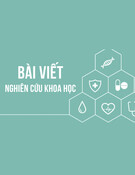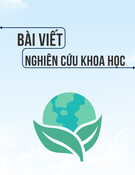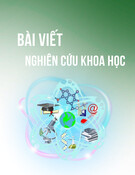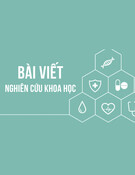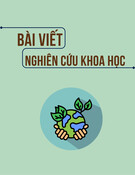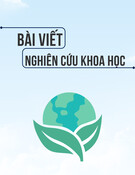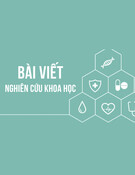
Journal of Water Resources & Environmental Engineering - No. 87 (12/2023)
64
Iot for sustainable water and wastewater management system - Case study
in Bac Hung Hai irrigation and drainage system
Nguyen Thu Hang
1
Abstract:
The Bac Hung Hai Irrigation System (BHH IS) is a crucial component of Vietnam's
agricultural sector, providing irrigation for various crops, livestock, aquaculture
, and domestic activities.
This is primarily due to capacity limitations, inadequate infrastructure, and decentralization of water
management. This study conducted a survey, collected and analyzed data to identify the water pollution
problem and the situat
ion of the operation and management of the Bac Hung Hai irrigation system.
From literature review and water polution management practices from other countries with similar
conditions, IoT solution and proposed main system for implementing real-time observa
tion and
controlling of
water quality are recommended to improve the water pollution problem and water
management in BHH IS.
Keywords: Sustainable water, waste water management, Iot, sensors, irrigation system.
1. Introduction
*
The irrigation system plays an important role
in ensuring irrigation for industrial crops and
rice, livestock, aquaculture and domestic
activities especially in the dry season. It
contributed greatly to the development of
Vietnamese agriculture sectors. Bac Hung Hai is
the largest irrigation system in the Red River
Delta, including land belonging to 22 districts
and cities of 4 provinces: Hai Duong, Hung
Yen, Bac Ninh and Hanoi. The total natural area
of the system is the 214,932 ha, of which
130,000 ha is arable land of all kinds, the Bac
Hung Hai system is responsible for providing
water for irrigation of 150,000 ha and ensuring
waterlogging for 185,600 ha of arable land
(Institute of Water, Irrigation, and Environment,
2019). Bac Hung Hai area has a fairly dense
system of inland rivers, which connect to each
other to form a convenient network of drainage.
However, in recent years, the irrigation
systems have deteriorated and severely polluted
1
Thuyloi University
Received 3
rd
Nov. 2023
Accepted 22
nd
Dec. 2023
Available online 31
st
Dec. 2023
especially Bac Hung Hai irrigation system.
According to the monitoring results of the Institute
of Water, Irrigation and Environment, the water
quality in the Bac Hung Hai irrigation system in
2019 has highest number of monitoring locations
exceeding the Vietnam Standard (QCVN) with
12/15 locations, accounting for 80% of the
monitoring positions (Institute of Water,
Irrigation, and Environment, 2019).
These problems are mainly due to lack of
capacity, inadequate public infrastructure,
decentralized water management (Klapetek et
al. 2010) and the lack of people’s consciousness
in the neighborhood area. Almost 100% of
domestic wastewater, livestock, craft villages
and 70-80% of industrial wastewater and
business establishments have not been treated or
meet the requirements before discharging into
the irrigation system. (Institute of Water,
Irrigation, and Environment, 2019). In addition,
The wastewater treatment plants are managed
by different localities, lacking coordination to
minimize water pollution. There is also a lack of
mechanisms for information exchange between
companies, hindering effective waste control
(decentralization). Moreover, in urban areas

Journal of Water Resources & Environmental Engineering - No. 87 (12/2023)
65
along the canal, there is a lack of waste control
systems. The water sector's digital transformation
has been slower compared to other sectors,
despite increased utilization of numerical tools
by water utilities (Jenny et al. 2020).
The research aims to address the
deteriorating and pollution issues in the Bac
Hung Hai irrigation system by implementing a
suitable and effective water and waste
management system based on IoT (Internet of
Things) and smart water management model. To
address these issues, the project proposes the
use of IoT technology and a smart water
management model. The IoT technology will
enable the collection and exchange of real-time
data on water quality, water levels, and water
flow within the irrigation system. This data can
then be analyzed to identify potential sources of
pollution and to optimize water usage and
distribution.
The ultimate goal of the project is to promote
sustainable development and improve the
quality and efficiency of water and waste
management in the Bac Hung Hai irrigation
system (BHH IS). By implementing IoT
technology and a smart water management
model, it is expected that the water quality will
be improved, water usage will be optimized, and
the negative impact on the environment and
human health will be minimized. This project
aligns with Vietnam's 5-year socioeconomic
development plan (SEDP), which emphasizes
sustainable development and the improvement
of quality and efficiency across various sectors,
including the water sector.
2. Methodologies
2.1. Research approach
A comprehensive approach that integrates
both technology push and demand pull practices
was applied in this research. Every innovation
compulsions can come from two different ways
technology push and market pull (Boehme,
1986; Brockhoff, 1969; Bullinger, 1994;
Schoen, 1967). In terms of technology, we
adopted an inheritance approach by gathering
information on existing technologies worldwide,
as well as studying the operations and
ecosystems in developed countries and countries
with similar conditions, such as India,
Bangladesh, and Thailand (Munde, 2019),
(Jahid et al., 2021), (Kaza et al., 2016). Five
ways to increase citizen participation in local
waste services. This provided valuable insights
for the development of our own system.
Figure 1. Research approach Technology push
and Demand Pull
Regarding the demand side, two approaches
were used i.e., the sustainability approach and
the community-based approach. The
sustainability approach entails considering the
long-term benefits and impacts on ecological,
social, and economic dimensions in the
planning of our smart system. This will ensure
the system's viability and effectiveness in the
long run. Furthermore, with the community-
based approach, we will actively engage with
the communities in their own environments.
This will involve conducting surveys and
collecting field data to better understand their
needs and preferences. We will also seek expert
opinions from organizations such as the Bac
Hung Hai Irrigation Works Exploitation One
Member Ltd.Company, as well as the District-
level Irrigation Works Exploitation Company.
This collaborative approach will ensure that our

Journal of Water Resources & Environmental Engineering - No. 87 (12/2023)
66
system is tailored to the specific requirements of
the communities it serves. By implementing this
comprehensive approach, we aim to address the
various challenges and complexities associated
with the development of our smart system,
ultimately leading to its successful
implementation and widespread adoption
research approach.
The methodologies used include:
- Inheritance methods and data processing
method: used to assess the Water quality
monitoring results in the BHH Water Resources
Program in the period 2005-2018, the
technology use case, operation; analyze the case
study of countries with similar condition.
- Method for zoning water pollution in Bac
Hung Hai: Based on field survey results, assess
the level of water pollution through sensory
assessment, color, stench, development status of
aquatic organisms combined with assessment by
Water quality index (WQI)
- Synthetic analysis method: combination of
collected documents, topographic survey,
discussion and semi-structured interview campaign
conducted in 2 communes Pham Tran and Thach
Khoi, including stakeholders at provincial involved
in the management and operation of the 2nd and
3rd canal, GAMA simulation model implemented
in Pham Tran town.
2.2. Research scope
The research scope includes the Bac Hung
Hai irrigation system, which encompasses 22
districts in Hai Duong, Hung Yen, Bac Ninh,
and Hanoi.
For the pilot research area, the focus of the
study was on Pham Tran Commune and Thach
Khoi Ward, specifically the Thach Khoi-Doan
Thuong canal in Hai Duong. Visits were made
to Bac Hung Hai company and Secondary level
management in Hai Duong, including the
People's Committee of Gia Loc District and the
local Irrigation Enterprise. Furthermore,
interviews were conducted with different
stakeholders in Pham Tran Commune and
Thach Khoi Ward, in accordance with the
community-approach in previous discussion.
Although, the areas located near each other,
they cover different geographic, level of water
pollution and economic activities, therefore
promote the idea for different purpose and help
to analyze the impact of different causes to
water pollution (Phuc, N.M, 2015).
3. Research results and recomendation
3.1. Pollution situation in Bac Hung Hai
Irrigation System
a. Regarding the pollution indicators
Based on the results of water quality
monitoring in the Bac Hung Hai irrigation
system from 2005 to 2016, there was an
increasing trend in water pollution levels and
extent. The table below presents an evaluation
of pollution levels based on the highest values
of several monitored indicators during this
period.
Table 1. Statistics of the highest values of monitoring indicators
Highest value of some indicator
No. Year COD (mg/l)
NH
4+
(mg/l)
NO
2-
(mg/l) PO
43-
(mg/l) Coliform
(MPN/100ml)
1 2005 42,8 18,48 3,96 3,04 2.400.000
2 2006 84,0 31,58 14,05 2,75 1.400.000
3 2007 75,7 27,72 1,96 2,04 1.200.000
4 2008 160,6 41,30 3,60 2,48 16.000.000
5 2009 176,4 26,88 1,04 2,76 16.000.000
6 2010 312,0 33,04 1,64 2,84 28.000.000

Journal of Water Resources & Environmental Engineering - No. 87 (12/2023)
67
Highest value of some indicator
No. Year COD (mg/l)
NH
4+
(mg/l)
NO
2-
(mg/l) PO
43-
(mg/l) Coliform
(MPN/100ml)
7 2011 368,0 35,00 0,76 2,24 17.000.000
8 2012 326,4 42,28 0,31 3,64 220.000.000
9 2013 225,12 40,66 0.80 2,46 1.600.000
10 2014 368,4 24,92 0,34 8.46 13.000.000
11 2015 146,4 29,12 0,62 1,58 540.000
12 2016 110,4 42,84 0,34 3,26 960.000
Source: Institute of Water, Irrigation and Environment 2005-2016
- The COD value showed the most
significant increase during the period 2005-
2014, primarily due to the rapid growth of
concentrated industrial zones in the system. The
management of waste from these industrial
zones was deficient, leading to increased
pollution levels. However, in the years 2015-
2016, the highest COD value started to decrease
as the industrial zones became more stable,
invested in wastewater treatment facilities, and
faced stricter waste management regulations
from the government.
Figure 2. Monitoring Indicators
- NH4+ and Coliform are mainly sourced
from domestic wastewater and livestock
wastewater, resulting in irregular fluctuations of
these substances depending on each year.
- The highest value of NO2- tended to
decrease due to changes in farming practices,
specifically more reasonable fertilization
methods employed by farmers.
In summary, from 2005 to 2016, water
quality fluctuations in the Bac Hung Hai
irrigation system showed an increasing trend in
both scope and extent. Over the span of more
than 10 years, COD content increased by 8.6
times, NH4+ increased by 2.48 times, PO43-
increased by 4.15 times, and Coliform increased
by 91.6 times. Although the heavy metal
indicators (As, Cr, Pb, Cd) did not exceed the
permissible limits set by the QCVN
(Vietnamese National Technical Regulation),
they have steadily increased over the years.
b. Pollution zoning
The zoning of water pollution in the Bac
Hung Hai irrigation system is determined
using the Water Quality Index (WQI) in
combination with an empirical analysis of
water pollution levels, considering factors
such as color, odor, and the living conditions
of aquatic species. The resulting pollution
zoning, depicting the areas affected by
polluted canals, is presented in Figure 3.
Source: Survey data
Figure 3. Pollution zoning by area
affected by polluted canals

Journal of Water Resources & Environmental Engineering - No. 87 (12/2023)
68
The area affected by seriously polluted
canals and ditches encompasses 90 out of 383
communes, accounting for approximately
23.5% of the total. Additionally, the area
affected by heavily polluted canals includes 82
out of 385 communes, representing about
21.41% of the total. The localities most severely
impacted by canal and water pollution are Gia
Lam and Long Bien districts in Hanoi, followed
by Hung Yen province, primarily concentrated
in My Hao, Van Lam, Yen My, and Khoai Chau
districts.
c. Waste sources in Bac Hung Hai
Irrigation system
According to a 2021 report by a specialized
agency, the Bac Hung Hai canal is significantly
polluted, with 70% of the pollution originating
from agricultural production, rural areas, craft
villages, and water from landfills. Industrial
production activities account for 28% of the
pollution, while medical activities contribute
2%. In terms of wastewater volume, Hung Yen
city has the highest discharge into the Bac Hung
Hai irrigation system, reaching 193,286 m3/day.
This is followed by Hai Duong (130,904
m3/day), Hanoi (73,037.10 m3/day), and Bac
Ninh (55,968.82 m3/day).
There are approximately 93 craft villages
operating within the Bac Hung Hai irrigation
system, such as plastic and metal craft villages,
recycling villages, wine-making villages, and
textile printing and dyeing villages. Although
they contribute a small percentage of pollution,
craft village wastewater plays a significant role
in causing water pollution. Unfolmost 100% of
domestic wastewater, livestock wastewater,
wastewater from craft villages, and 70-80% of
industrial wastewater and business
establishments are being discharged into the
wastewater treatment plant without proper
treatment or with unsatisfactory treatment.
3.2. The Management system of Bac Hung
Hai Irrigation system
The Bac Hung Hai irrigation system is under
the management of the General Department of
Irrigation, supervised by the Ministry of
Agriculture and Rural Development. Fig 4
indicates the diagram of management system of
Bac Hung Hai irrigation system.The main
management unit is the Bac Hung Hai Company
(IDMC), with each province having its
subsidiary or representative overseeing
irrigation works in their respective areas.
However, the management of this complex
system faces challenges, including a lack of
capacity and cooperation among the different
units involved, specifically:
- Environmental management lacks a
specialized department or dedicated staff for
oversight.
- Lack of regular waste source management,
exacerbated by insufficient equipment and skills.
- There is no assignment of responsibilities
and a coordination mechanism between the
wastewater mining units, related sectors and
local authorities at all levels in wastewater
management.
Figure 4. Management Diagram of of BHH IS
3.3. IOT Solution and Recommendation
For the technology side, in urban localities,





![Hiệu quả tiêu năng của mũi phun hai tầng [Mới Nhất]](https://cdn.tailieu.vn/images/document/thumbnail/2025/20250509/bachlapkim01/135x160/7891746785340.jpg)





![Tài liệu Vi sinh vật môi trường [Mới nhất]](https://cdn.tailieu.vn/images/document/thumbnail/2025/20251123/ngkimxuyen/135x160/21891763953413.jpg)
![Sổ tay truyền thông Phân loại chất thải rắn sinh hoạt trên địa bàn tỉnh Quảng Nam [Chuẩn nhất]](https://cdn.tailieu.vn/images/document/thumbnail/2025/20251114/kimphuong1001/135x160/1701763094001.jpg)
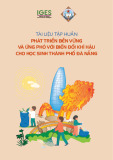
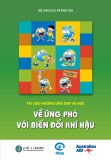
![Quản lý chất thải nguy hại: Sổ tay Môi trường [Chuẩn nhất]](https://cdn.tailieu.vn/images/document/thumbnail/2025/20251029/kimphuong1001/135x160/9011761720170.jpg)

